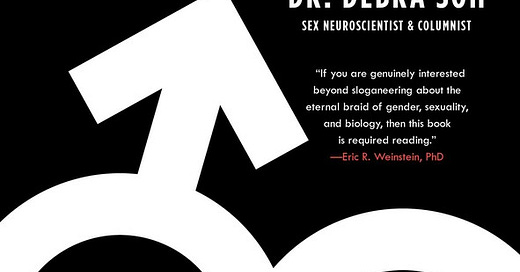Book Review: The End of Gender by Dr. Debra Soh
“Scientific research is no longer about exploring new ground but promoting ideas that make people happy.”
The End of Gender: Debunking the Myths About Sex and Identity in Our Society by Dr. Debra Soh. Narrated by Dr. Debra Soh. Simon & Schuster Audio, 2020. 8 hours (approx.).
Dr. Debra Soh is an international sex researcher, neuroscientist and columnist. She obtained a Ph.D. in sexual neuroscience from York University in Toronto and studied paraphilia in men. She has written for numerous publications such as New York magazine and The Wall Street Journal. She currently hosts The Dr. Debra Soh Podcast.
The End of Gender: Debunking the Myths About Sex and Identity in Our Society is her first book. It is an attempt to separate the wheat from the chaff - what is science and what is ideology concerning sex, gender and identity. She organizes her book into nine myths, devoting a chapter to debunking each one. The nine myths are:
Biological sex is a spectrum.
Gender is a social construct.
There are more than two genders.
Sexual orientation and gender identity are unrelated.
Children with gender dysphoria should transition.
No differences exist between trans women and women who were born women.
Women should behave like men in sex and dating.
Gender-neutral parenting works.
Sexology and social justice make good bedfellows.
To reiterate, the above list are the myths. Dr. Soh makes arguments against those statements.
I have been meaning to read a book on this subject for some time and chose Dr. Soh’s on the suggestion that it was more sympathetic to the trans movement than, say, Abigail Shrier’s Irreversible Damage (which I have not read). Unfortunately, Soh’s sympathy is groveling at times. The truth is a bitter pill, and Soh coats it with so much sugar that I am afraid I have diabetes.
To be fair, she has faced severe backlash for her opinions on this matter, so it is no wonder she goes out of her way to remind the reader that she supports the rights of everyone, trans included.
One group Dr. Soh is not very sympathetic towards is men. A former feminist, her views on men are less than enlightened. While she laments the necessity of carrying numerous cosmetics through airport security to maintain her beauty regimen, she speaks barely a word about men taking high-risk “death profession” jobs to be attractive. This is just one example. I can’t imagine Soh didn’t read Dr. Farrell’s The Boy Crisis, but it seems like she hasn’t.
Be that as it may, she is a credible expert who clears up the confusion around sex, gender and identity. She also gives tips on how to recognize the difference between science and ideology.
Sex is defined by the creation of gametes. There are only two: egg and sperm. “There are no intermediate types of gametes between egg and sperm cells. Sex is, therefore, binary. It is not a spectrum,” writes Soh.
Intersex individuals are born with mixed sex characteristics such as ovotestes, which are gonads that share aspects of both testicles and ovaries. Some cite intersex people as evidence that sex is not binary. However, intersex people still produce only one of the two gametes or are infertile. They are also so rare (less than 1%) that Soh suggest the definition of sex need not be changed over it. It would be like redefining the number of fingers humans have because sometimes a person is born with fewer or more.
As for infertile people such as post-menopausal women who are still considered women despite not producing gametes, Soh says this is a weak, ideologically driven argument. “Activists wish to reinvent sex in this way because it allows for the separation of sex from an objective basis in reality.” Science is a barrier to their unsupported theories, and this reinvention allows them to remove that barrier. They have a predetermined outcome in mind and are reverse engineering the facts to suit it.
Gender identity is whether a person feels masculine or feminine. Gender expression is the external manifestation of a gender identity such as hairstyle and clothing. For example, a person who identifies as female will express herself by wearing a dress.
Soh writes, “Socialization shapes the extent to which our gender is expressed or suppressed, but it doesn’t dictate whether someone will be masculine or feminine …” What does determine masculinity or femininity is exposure to testosterone in the womb.
She continues:
Humans are a sexually dimorphic species with two different types of gametes: eggs and sperm. Intermediate gametes don’t exist. Since biological sex and gender are both defined by these parameters gender is by definition, like sex, either male or female, binary and not a spectrum.
The fa'afafine of Samoa are considered to be a third gender and therefore often cited as evidence of gender’s social construction. However, the fa'afafine acknowledge they are male and “they don’t transition to the opposite sex and have no desire to become women. They aren’t considered the opposite sex within their culture and do not wish to be.” Trans activists are reinterpreting the fa'afafine’s way of life through their own ideological lens.
Gender dysphoria rests on the idea that gender is innate, that the brain of one sex can exist in the body of the other. Gender as a mutable social construct contradicts this. If gender can change it could be possible to align one’s gender with his birth sex.
Gender dysphoria is a medical condition defined by the DSM5 as distress at the incongruence experienced between one’s experienced gender identity and one’s birth sex, according to Soh. Transgender, on the other hand, is an identity and a political label that denotes when someone identifies as the opposite sex. A child may be diagnosed with gender dysphoria but cannot be transgender because “children and particularly prepubescent children do not possess the emotional maturity to identify this way,” writes Soh.
Whether a child diagnosed with gender dysphoria should transition is a complicated matter. Soh says these kids should be accepted by their parents and be treated with compassion, but this does not require social or medical transition. She says the therapeutic approach (aka the developmental model) is the most appropriate method as it is backed by science. It allows a child to explore his gender while being open to the possibility of growing comfortable with his birth sex.
Most children diagnosed with gender dysphoria desist at puberty and often grow up to be gay men. The few who persist (10% to 40% depending on the study) may benefit from medical intervention, but “we cannot yet predict who these ideal candidates will be.” Even a social transition can be traumatic. Clinicians, therefore, ought to approach transitioning carefully and rule out all other possibilities first, Soh recommends.
A 2014 study that suggests 41% of trans adults attempt suicide. However, the people in the study were not asked about comorbidities, such as other mental health conditions. They also were not asked if they identified as trans at the time of the attempt. “It is possible that the suicide attempts reported by the individuals in this study had nothing to do with how they felt about their gender.” It must also be noted that no children were involved in this study.
There is a 36 to 1 ratio between liberals and conservatives in academia, “an astounding gap that has serious implications for the knowledge being produced in the academy,” writes Soh. She laments that because leftist activism has polluted scientific research not all published papers can be trusted. She gives the following advice for determining what can or cannot be trusted.
First, look up a paper’s coauthors. If hard scientists are collaborating with a non-science department, it’s a good indication they are using an ideological framework through which to interpret their findings. Suspect departments may include philosophy, English and education as well as those using words like “studies” such as gender studies, women’s studies, queer studies or cultural studies.
Second, check the researcher’s university profile. Does he use buzzwords like inequality, lived experience or patriarchy or calls attention to his race, gender, sexuality or status as a feminist? Soh says these should not matter to one’s research and are inappropriate to bring up in an academic setting.
Third, check the researcher's social media content. Does he block people without sufficient provocation or engage in ad hominem attacks?
Finally, get original sources whenever possible. Too often reporters make mistakes or deliberately misrepresent studies.
Dr. Soh writes in the introduction to The End of Gender:
Gender has transformed into a cult-like concept, and public knowledge has been overturned to reflect pleasantries that affirm the feelings and beliefs of particular groups. Scientific research is no longer about exploring new ground but promoting ideas that make people happy.
But she concludes the book on a hopeful note. While concerned for the future of sexology she nevertheless writes, “I do think science will eventually prevail. It may simply take some time before we get there … the truth can be suppressed but it’ll always come out.”




